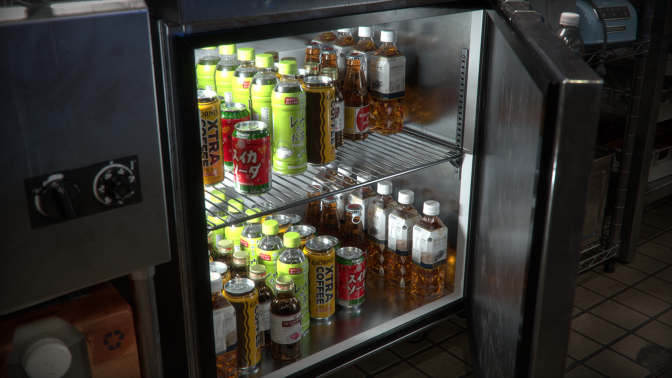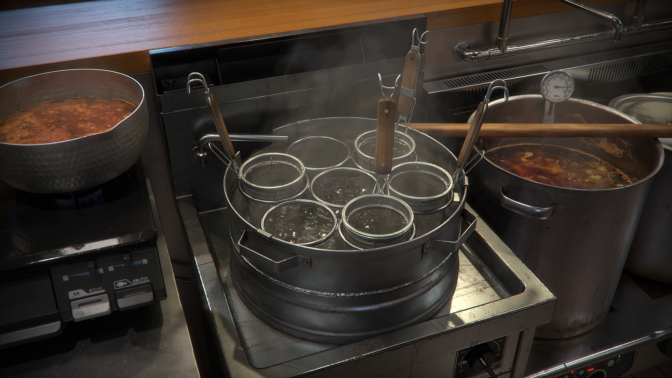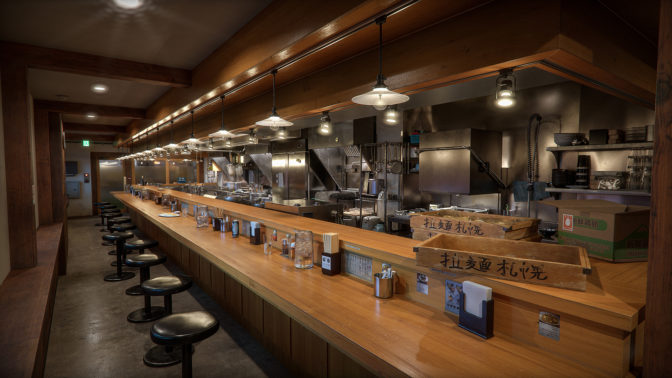When brainstorming a scene to best showcase the groundbreaking capabilities of the Omniverse platform, some NVIDIA artists turned to a cherished memory: enjoying ramen together in a mom-and-pop shop down a side street in Tokyo.
Simmering pots of noodles, steaming dumplings, buzzing kitchen appliances, warm ambient lighting and glistening black ledger stools. These were all simulated in a true-to-reality virtual world by nearly two dozen NVIDIA artists and freelancers across the globe using NVIDIA Omniverse, a 3D design collaboration and world simulation platform.
The final scene — consisting of over 22 million triangles, 350 unique textured models and 3,000 4K-resolution texture maps — welcomes viewers into a virtual ramen shop featured in last month’s GTC keynote address by NVIDIA founder and CEO Jensen Huang.
The mouth-watering demo was created to highlight the NVIDIA RTX-powered real-time rendering and physics simulation capabilities of Omniverse, which scales performance and speed when running on multiple GPUs.
It’s a feast for the eyes, as all of the demo’s parts are physically accurate and photorealistic, from the kitchen appliances and order slips; to the shoyu ramen and chashu pork; to the stains on the pots and pans.
“Our team members were hungry just looking at the renders,” said Andrew Averkin, senior art manager and lead environment artist at NVIDIA, in a GTC session offering a behind-the-scenes look at the making of the Omniverse ramen shop.
The session — presented by Averkin and Gabriele Leone, senior art director at NVIDIA — is now available on demand.
Gathering the Ingredients for Reference
The team’s first step was to gather the artistic ingredients: visual references on which to base the 3D models and props for the scene.
An NVIDIA artist traveled to a real ramen restaurant in Tokyo and collected over 2,000 high-resolution reference images and videos, each capturing aspects from the kitchen’s distinct areas for cooking, cleaning, food preparation and storage.
Then, props artists modeled and textured 3D assets for all of the shop’s items, from the stoves and fridges to gas pipes and power plugs. Even the nutrition labels on bottled drinks and the buttons for the ticket machine from which visitors order meals were precisely replicated.

In just two months, NVIDIA artists across the world modeled 350 unique props for the scene, using a range of design software including Autodesk Maya, Autodesk 3ds Max, Blender, Maxon Cinema 4D and Pixologic Zbrush. Omniverse Connectors and Pixar’s Universal Scene Description format enabled the models to be seamlessly brought into the Omniverse Create app.
“The best way to think about Omniverse Create is to consider it a world-building tool,” Leone said. “It works with Omniverse Connectors, which allow artists to use whichever third-party apps they’re familiar with and connect their work seamlessly in Omniverse — taking creativity and experimentation to new levels.”
Adding Lighting and Texture Garnishes
Artists then used Adobe Substance Painter to texture the materials. To make the props look used on a daily basis, the team whipped up details like dents on wooden counters, stickers peeling off appliances and sauce stains on pots.
“Some of our artists went as far as cooking some of the recipes themselves and taking references of their own pots to get a good idea of how sauce or burn stains might accumulate,” Averkin said.
Omniverse’s simulation capabilities enable light to reflect off of glass and other materials with true-to-reality physical accuracy. Plus, real-time photorealistic lighting rendered in 4K resolution created an orange warmth inside the cozy virtual shop, contrasting the rainy atmosphere that can be seen through the windows.
Artists used Omniverse Flow, a fluid simulation Omniverse Extension for smoke and fire, to bring the restaurant’s burning stoves and steaming plates to life. SideFX Houdini software helped to animate the boiling water, which was eventually brought into the virtual kitchen using an Omniverse Connector.

And Omniverse Create’s camera animation feature allowed the artists to capture the final path-traced scene in real time, exactly as observed through the viewport.

Learn more about Omniverse by watching additional GTC sessions on demand — featuring visionaries from the Omniverse team, Adobe, Autodesk, Epic Games, Pixar, Unity and Walt Disney Studios.
Join in on the Creation
Creators across the world can download NVIDIA Omniverse for free, and enterprise teams can use the platform for their 3D projects.
Join the #MadeInMachinima contest, running through June 27, for a chance to win the latest NVIDIA Studio laptop.
Connect your workflows to Omniverse with software from Adobe, Autodesk, Epic Games, Maxon, Reallusion and more.
Follow Omniverse on Instagram, Twitter, YouTube and Medium for additional resources and inspiration. Check out the Omniverse forums and join our Discord Server to chat with the community.
The post Let Me Shoyu How It’s Done: Creating the NVIDIA Omniverse Ramen Shop appeared first on NVIDIA Blog.
